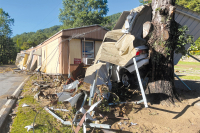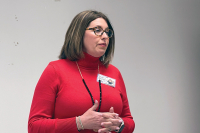Community collaborates to help Jackson’s uninsured, groom future medical professionals
 When someone shows up to a medical clinic, sick and suffering, the hardest words to say can be, “Sorry, but you’ll have to wait three months for an appointment.”
When someone shows up to a medical clinic, sick and suffering, the hardest words to say can be, “Sorry, but you’ll have to wait three months for an appointment.”
And that’s how the folks at Good Samaritan Clinic in Sylva had been forced to respond to the uninsured, underinsured, down-on-their luck patients who came through the free clinic’s doors in search of care. Though the clinic had a registered nurse there four days a week, most medical needs had to wait until Tuesday night, when a volunteer force of students and medical professionals from across the region would descend to provide a range of services.
But helping the backlog of patients in need would require more than a few hours per week.
“What we knew was happening was people were coming to us in need in the moment, and we couldn’t help them for three to four months,” said Rebecca Mathis, executive director.
And if they needed a follow-up visit? That might not happen for another two to three months. With that kind of timeline, little problems could easily morph into big ones before the scheduled appointment came around.
That’s no longer the case, due to a $225,000 grant that Judy Neubrander, director of Western Carolina University’s School of Nursing, secured from the Golden LEAF Foundation last year. The program, Increasing Nurse Practitioners in Underserved Territories (INPUT) funds two years of salary to put a full-time nurse practitioner at Good Sam — who also acts as a preceptor for the university, each year giving nine WCU nurse practitioner students on-the-ground training in rural health care.
Related Items
The goal? To get students interested in a career helping underserved areas in Western North Carolina.
Bridging the gap
The clinic’s new nurse practitioner is Janet James, a Sylva resident whose passion for underserved populations has led her on medical trips to Honduras and Peru — she speaks fluent Spanish — and now to her new job at Good Samaritan.
James’ job is a balancing act, a combination of delivering diagnoses and medical opinion alongside the softer skills of leveling with patients, getting an idea of where they’re coming from and what might be preventing them from getting better. Then there’s the interaction with students, in itself a dichotomy between the medical and the cultural.
“What’s making this particular job really interesting to me is we get students in who have never seen this side of life,” James said. “They’ve never seen poverty or people that are in so much need — not just of medical care, but they need psychological support, and we give a lot of that here.”
The population that frequents the Good Samaritan Clinic is a different set than what you’d see in a typical doctor’s office. Some of them are homeless; others struggle with substance abuse or mental illness. Some work multiple low-paying jobs but just can’t get insurance. Some have just gotten out of jail or have found themselves suddenly in need of help to get through a crisis.
“I consider it a privilege to work with these people and know what their sufferings are,” James said. “To know what their story is.”
Knowing the story is about as important as knowing the medical history. Discovering the human dimensions of a person’s life that reveal why they’re having trouble sleeping or why they’re smoking too much are pivotal to finding a solution. Especially when you’re dealing with a population that’s not going to be able to afford expensive medical solutions.
“They’re (WCU students are) learning that we need to consider what the patient can afford or can’t afford, the economics of healthcare,” said Neubrander.
Mathis is excited to have James — because of the service her position provides, but also because of her ability to fit so tightly with the clinic’s needs and mission.
“It’s been delightful, and the students, they’ve sought Janet out,” she said.
The power of connection
Susannah Francis is one of those students.
A nurse for 15 years, Francis is set to graduate from WCU’s nurse practitioner program in May. She was fully expecting that she’d have to search out a clinical site on her own, but then she got an email about the INPUT program.
“I read that email and immediately called Dr. Janet (James), because that’s where my heart lies is with that demographic, that group of folks that are served by the clinic, so I just immediately jumped on it and loved, loved it,” said Francis, who worked at Good Sam from August to November 2015. “It was one of those experiences that you have in your life that you always kind of look back on.”
Francis has worked in an emergency room before, and she’s worked as a flight nurse. She’s seen, over and over, what the point of no return looks like. Thrust into a clinic that deals with people on the brink, people for whom the system of insurance and copayments and coinsurance is not working, she felt like she was making a difference, catching people before they began to fall. She felt herself move into a productive overdrive of critical thinking, of figuring out how to get this medicine or that procedure to her patient for a price they could afford.
That’s the kind of thing Good Samaritan deals with every day. For instance, Mathis said, a while ago a patient showed up who had contracted Hepatitis C. There’s a drug for that — but it retails for $80,000.
“We were able to get his medicine for free,” Mathis said. “He has been able to go on a treatment plan and now his lab work has shown he is completely clear of Hepatitis C.”
Sometimes, the treatment comes with a softer touch.
One of Francis’ patients was a young girl who was extremely obese. She wanted to lose weight.
So Francis talked with her — about her goals, about where she was in life — and even shared her own experience with weight loss. The next time she came in, the patient had lost 8 pounds. The next time, 10.
“Being able to follow up with her and really make that connection with her and see how a simple suggestion — nothing medical, no pills, no medicine; just connecting with a patient, listening to them, giving them support and meeting them where they are — was fantastic,” Francis said.
Without the INPUT program, that patient may have never gotten follow-up.
Funding the future
Good Samaritan’s leadership is hoping that the increased level of care will have a positive impact on purse strings as well as on heartstrings. WCU and Good Sam have been talking to Harris Regional Hospital throughout the process, hoping they might be able to get the hospital to fund James’ position when the two-year grant ends in June 2017.
“We’re increasing our visits in the free clinic, decreasing our visits in the ER (emergency room) that are unpaid,” Neubrander said. “After two years, hopefully Duke LifePoint and Harris Regional will realize a savings equivalent to what would be a family nurse practitioner salary, and they would take over the salary for the family nurse practitioner. That’s kind of the ultimate goal.”
Often, people without health insurance will show up at the ER to get care that, while necessary, doesn’t qualify as “emergency.” The hospital has to see the patient anyway, and when the patient doesn’t pay the resulting bill, the hospital loses out. If transferring those non-emergency — and non-paying — cases can save the hospital money, funding James’ position might make financial sense for Harris.
The hospital hasn’t committed to anything of the sort, yet. But they’re thinking about it, keeping careful records of how the number of non-emergency visits to the emergency department shifts over the life of the grant.
“It’s conversational right now,” said Anetra Jones, chief nursing officer for Harris. “But obviously if it continues to go in this positive direction, then it would certainly be worth our looking at it from a hard investment standpoint.”
At this point, Jones has only “soft” numbers on the project’s impact. The grant just started in July, so it’s less than halfway through. However, some decrease in the number of visits from Good Samaritan patients is apparent already. Jones puts the figure somewhere around 5 percent, which is noteworthy but still a good ways from the 20 percent target.
Jones is hopeful about the end result. It takes time to educate people about the services now available at Good Samaritan. She expects the decrease in emergency room visits to pick up.
“As more of those patients from the Good Sam Clinic learn about the more open hours, I think we’ll see an even bigger decrease,” Jones said.
On Good Sam’s end, the numbers are already pretty compelling. In 2014, the clinic saw 427 different patients over 877 visits. By the end of 2015, those numbers had exploded, with the number of patients increasing 22.7 percent to 524 and the number of visits ballooning by 85.3 percent to 1,625.
Mathis attributes those figures directly to James’ presence.
“Janet (James) was only here half of 2015,” Mathis said. “That was a rapid increase.”
The skyrocketing number of provider visits is especially notable, Mathis said. That means that not only are people able to see someone who can mitigate a crisis, they’re able to get the follow-up care they need to keep the recovery long-term.
“I’m very excited to see what next year will bring,” she said.
Embraced by the community
The nurse practitioner program isn’t the only thing that Good Sam has going for it at the moment. The organization’s been experiencing a piling-on of support, from community donations and grants. Last week Mathis thanked Jackson County Commissioners for the $61,400 they appropriated to Good Samaritan last year. That investment helped the organization make its case not only for the Golden LEAF grant but also for the $80,000 grant it received from Sisters of Mercy in Asheville to fund a nurse case manager position.
Currently, Good Samaritan is a finalist for a competitive Melvin R. Lane Fund grant, hoping to secure funding for a full-time development person.
That position, Mathis said, would “lead us toward a sustainable model which is something all non-profits struggle with.”
Four of Good Samaritan’s five full-time staff and two of its three part-time staff are grant-funded.
The web of dollars and regulations and human need isn’t an easy one to navigate. But it’s not hard to see that good things are happening at Good Sam.
And, to the INPUT program’s double-sided goal of providing care and training students in a passion for rural health care, it appears that’s working too. At least in Francis’ case, anyway.
With graduation on the horizon, her house in Asheville is for sale and she’s thinking about what might come next. She’s hoping that, whatever it is, it’s in Western North Carolina.
“I love this community and feel like that’s kind of my responsibility,” she said. “I’ve been blessed to be able to go to nursing school and nurse practitioner school and have all these experiences through work, and I can use all that and put it in the community where I got it from.”
By the numbers
- 29 percent of Jackson County adults uninsured in 2013, compared to 25 percent in Western North Carolina and 22.5 percent statewide.
- 85.3 percent increase in visits to Good Samaritan Clinic in Sylva from 2014 to 2015, rising from 877 to 1,625.
- 22.7 percent increase in individuals seen at Good Samaritan from 2014 to 2015, rising from 427 to 524.
- $3.1 million in donated care, services and support to Good Samaritan in 2015.
- $11.66 in services provided to patients in 2015 for every $1 spent.
- 155 volunteers logged 4,104 hours at Good Samaritan in 2015.
Source: Good Samaritan Clinic
Why nurse practitioners?
“Nurse practitioner” might not roll off the tongue as easily as “doctor,” but the profession will likely gain increasing importance amid the changing landscape of health care, especially in rural areas.
“With the Affordable Care Act, there’s going to be a greater need for lives covered by health care,” said Judy Neubrander, director of Western Carolina University’s School of Nursing. “Especially in rural areas such as Western North Carolina, there are not enough physicians practicing. Nurse practitioners are going to help with that.”
Like doctors, nurse practitioners can see patients, diagnose and write prescriptions. If something turns up beyond the scope of their training, they can always make a referral.
Nurse practitioners tend to be more numerous than doctors, however. Nurse practitioners hold master’s degrees, so there’s less schooling involved than for doctors, and an individual can work their way up the ladder from certified nursing assistant to registered nurse to nurse practitioner, juggling school and work all the way.
And, because of the nursing-based philosophy they come from, nurse practitioners can sometimes be better suited to the challenges of rural health care, where socioeconomic factors are often strongly in play.
“It’s not just about the problem they (patients) have,” said Janet James, nurse practitioner for the Good Samaritan Clinic in Sylva. “It’s about who is their family and what is their culture and what is their support system and what is their socioeconomic background, because all of these things are going to factor into how we take care of them and how they take care of themselves.”









